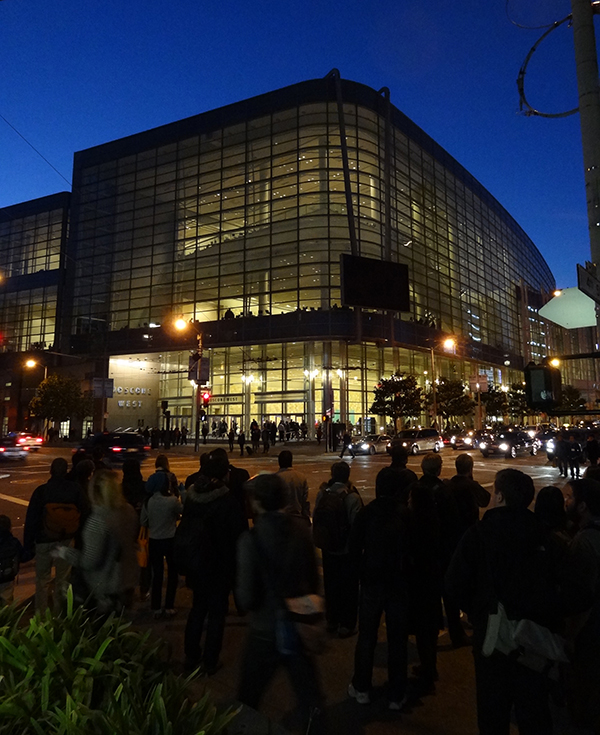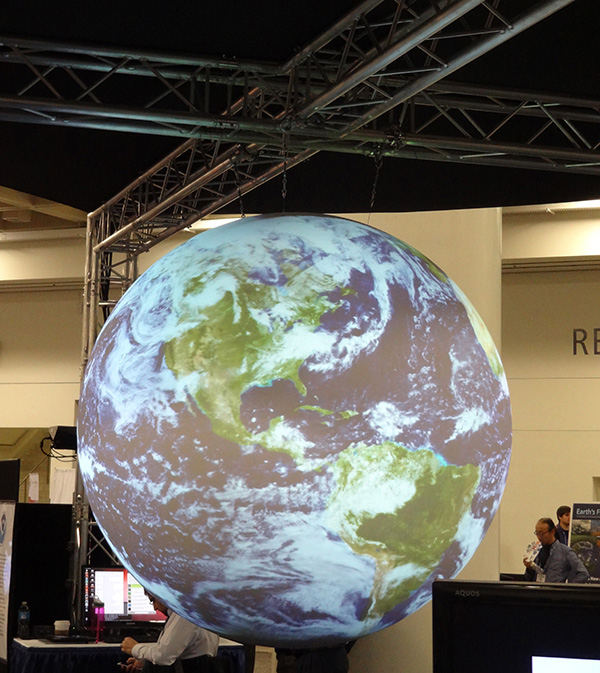
by Timothy Oleson Tuesday, December 17, 2013

Outside the Moscone Center in San Francisco, Calif., site of the American Geophysical Union meeting last week. Timothy Oleson

The exhibition hall at the 2013 American Geophysical Union meeting in San Francisco, Calif. Timothy Oleson

NOAA's Science On a Sphere at AGU 2013. Timothy Oleson
It’s back to the office this week for several EARTH staffers, including myself, who attended the annual meeting of the American Geophysical Union in San Francisco last week in search of interesting story ideas and fascinating folks in geosciences that we might cover in upcoming issues. With more than 20,000 participants, 7,000 research talks and invited speeches, and 14,000 posters, along with numerous other activities, there was plenty of potential material, and we spent some long days absorbing as much we could.
Although we certainly didn’t make it to every talk or poster — you’d need a small army to accomplish that — and we haven’t yet compared all our notes, it’s clear that there was, as usual, plenty of great science on display (some of which we’ve already covered here, here, here and here). With that in mind, keep an eye out for mentions of the conference in EARTH in 2014. For now, I thought I’d touch on a few highlights of AGU 2013. Of course, these represent an extremely limited sampling drawn from my own wanderings through the Moscone Center, so my apologies for excluding so much.
SinoProbe: The state-sponsored SinoProbe is the Chinese equivalent of the United States' Earthscope, and its main objectives are to provide detailed data on the structure, lithology and geochemistry of the continental crust beneath China. At a press conference Monday, Dec. 9, several team members, including project principal investigator Dong Shuwen of the Chinese Academy of Geological Sciences and Simon Klemperer of Stanford University, outlined findings from the massive program’s initial phase, which lasted from 2008 through 2012, and laid out upcoming goals. According to information provided by the team, nearly 600 broadband seismometers have been deployed, thousands of kilometers of seismic reflection profiles have been shot, and roughly 20,000 samples have been collected for geochemical and mechanical analyses, among other achievements. If the next stage of SinoProbe is fully funded, Klemperer said, China could “leap-frog” past the U.S. and Europe in its understanding of its subsurface.
Geoscience Games: In a Monday afternoon session entitled “Games, Interactive Simulations, and Virtual Labs for Science Teaching and Learning,” eight speakers talked about a variety of efforts to engage students in science through creative and interactive media, as well as attempts to gauge the successes and failures of the games in the teaching process. Astronomy and Earth’s climate were the two most common subjects, although games are also being developed to help students understand earthquakes and explore the deep sea. In addition to personal computers, platforms for which games are being developed include mobile devices, Facebook and even Xbox 360.
Mermaids: At a press conference Monday, Dec. 9, scientists discussed the recent deployment and testing of several MERMAIDs (Mobile Earthquake Recorder in Marine Areas by Independent Divers). Essentially seismometers at sea, the instruments are intended to record earthquake signals in the ocean — where seismic measurements have traditionally been few and far between — and help researchers better characterize unknown parts of Earth’s internal structure. Soon after the first two MERMAIDs were deployed in the Mediterranean in December 2012, they detected a magnitude-6 temblor that had occurred 5,000 kilometers away. The seagoing instruments improve upon conventional hydrophone networks used to detect seismicity because they are mobile, relatively low-cost and can be retrieved easily, and the early success “gives us confidence that we can open up the oceans,” said Guust Nolet, a geophysicist with Géoazur in France. The team has plans to deploy 10 additional MERMAIDs this spring, and hopes to eventually deploy as many as 300 to 400 if funding permits.
James Hansen: After his Tuesday afternoon “Union Frontiers of Geophysics” talk was canceled at the last moment (leaving a packed assembly hall perplexed as to why he wasn’t there), Hansen’s lecture was rescheduled and held Wednesday. After explaining that his absence on Tuesday was due to the fact that he simply didn’t realize he was on tap to give three talks at the conference instead of two, and thus didn’t show up (a surprising lapse in communication between he and the conference organizers given the top billing of the lecture), he spoke about what he sees as the undeniable influence of man on Earth’s climate and his view that world powers should put a price on carbon. An odd moment in the talk occurred when Hansen played a four-plus-minute video clip from a 1979 anti-nuclear concert — featuring an impassioned Ralph Nader, an elderly firebrand espousing her love of coal, and thousands of protestors singing along to no-nuke folksongs — to make the point that people were more upset, ironically in hindsight, by the prospect of nuclear energy then than they are now about the continued heavy use of coal. It’s a valid point perhaps, but one that could have been made without treating the crowd to several uncomfortable minutes.
Science On a Sphere: OK, I know many people have undoubtedly seen NOAA’s “Science On a Sphere” (SOS) setup before, as it has been around since the 2000s, but this was the first time for yours truly. And what can I say but … It’s awesome! It is basically a large blank orb onto which animations can be projected by several video projectors surrounding it. Originally conceived of as a way to better visualize scientific data, it has largely become a tool for education and outreach purposes, installed in museums and schools around the world. At AGU 2013, SOS was seemingly one of the more popular displays in the exhibition hall, along with both Google’s and NASA’s booths.
Oh, the weather outside … was gorgeous: The weather couldn’t have been much better for the conference last week, making the frequent outdoor jaunts among the three buildings of Moscone Center a pleasure. Temperatures were apparently a bit below normal in San Francisco, but with highs between about 11 and 14 degrees Celsius and mostly sunny skies (and having come from the chilly climes of Wisconsin), it sure felt nice to me!
© 2008-2021. All rights reserved. Any copying, redistribution or retransmission of any of the contents of this service without the expressed written permission of the American Geosciences Institute is expressly prohibited. Click here for all copyright requests.